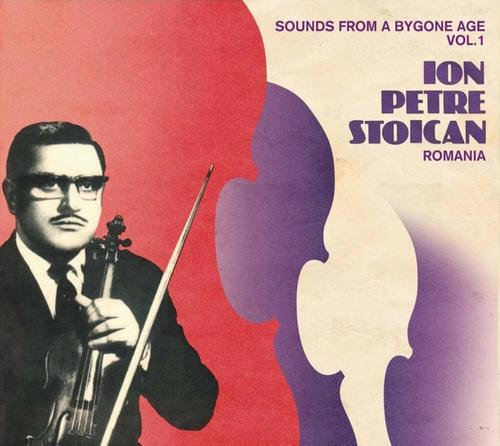
Recordings from the former Romanian comunist state record label, featuring Ion Petre Stoican.
"This story took place before 1965. One day Stoican noticed a man who seemed to him to be behaving suspiciously. This stranger turned out to be a foreign spy. Stoican grabbed him and took him to the nearest police station. The secret police then asked what he would like as a reward. 'Should we give you a house?' - 'I don't need a house,' Stoican replied, 'I want to make a record.'" (Quote COSTEL VASILESCU, Bukarest 2005) On the only long-playing record by the Romanian violinist Ion Petre Stoican the most important Gypsy musicians from the Bucharest Lautari scene were united in an All-star band and through a bizarre stroke of luck created one of the most atmospheric records of the time. Most of the pieces played came from Constanta and from Stoican's birthplace Oltenita, and are primarily fast rhythmic dances such as Hora, Briu, Sirba or Geamparale, which no wedding could do without. Recovered from the archives of Electrecord and out on CD now: Romanian traditional music in original analog sound recorded in the 1970s! "Our names were not mentioned, but Stoican still managed to get our photo on the album", recalls Costel Vasilescu, whose bright trumpet tone made him a legend throughout Romania. But the names of the musicians are only rarely to be found on the records released during the Ceausescu period - even Vasilescu is not mentioned on recordings made by Gabi Lunca or Romica Puceanu - Rumania's Gypsy Queens - who regularly called him into the studio at that time. The term "People's Orchestra" is used to describe the musicians on Ion Petre Stoican's only LP released in 1977. Costel Vasilescu lives in a town house, that was luckily not torn down in the demolition fever of the 1980s. The heavy furniture, dark silk and crystal chandeliers in the living room are less status symbols than a sign of the time when Vasilescu played at four weddings a week. His memories are palpable and the photographs of celebrations or concerts are carefully stored in thick photo albums. The only photograph Costel Vasilescu cannot find is one of Ion Petre Stoican, the violinist from Constanta. And yet this man through a spectacular piece of luck created one of the most atmospheric records in the history of the Lautari. Accompanied by the tzimbal god Toni Iordache, the accordion dervish Ionica Minune and Costel Vasilescu on the trumpet: "This story took place before 1965 during the regime of Gheorghiu Dej. Ion Petre Stoican caught a long sought-after spy. At the time Stoican was living at the coast and played in restaurants and at weddings, he was reasonably successful - but in Bucharest he was relatively unknown. One day he noticed a man who seemed to him to be behaving suspiciously. This stranger turned out to be a foreign spy, who was trying to hide a parcel full of dollar bills and a letter. Stoican grabbed him and took him to the nearest police station. They had been looking for this man for a long time and were very pleased about this unexpected catch. The secret police asked Stoican what he would like as a reward. 'Should we give you a house?' - 'I don't need a house,' Stoican replied, 'I want to make a record." And in 1966 the monopolist Romanian publishing house Electrecord released the first four-track Stoican album. That in itself was a sensation, because Ion Petre Stoican, who was born in 1930 in the small town of Oltenita, was related to the exceptional violinist Ion Nomol, but he was not famous like Toni Iordache or Romica Puceanu. He came to Bucharest as a young man and played the full repertoire of standards that was typical for weddings. With all the ritual dances and songs, from dressing the bride (Ia-ti mireasa, ziua buna) right up to the "Dance of the witnesses". Then he left the scene for the port town of Constanta for almost 15 years; business on the coast was more lucrative for the violinist from the province, because the claims in Bucharest had already been staked by the old-established Lautari families. Following the death of his wife, Ion Petre Stoican returned to Bucharest in the mid-seventies. He then took his spy story back to the authorities, building up a huge dossier and besieging the officials until he was given the green light for an LP. This was a once-in-a-lifetime opportunity. Stoican wanted to play with the most adventurous musicians in Romania, as the record was to be his breakthrough. He wasn't a virtuoso violinist of the stature of Aurel Gore, but he was ambitious enough to form an all-star band for his first album. "And then he came to me and asked me if I could help him to realise his vision", Costel Vasilescu reports. Vasilescu, who is a great diplomat and judge of human nature, at first said he would "see what can be done." He accompanied Stoican to the No. 1 tzimbal player in Romania, Toni Iordache, who held court in the "Boulevard" restaurant and waited for engagements while drinking Turkish coffee. Of course Toni Iordache couldn't say yes straightaway, because he was an international star, and Stoican in his eyes was a second-class musician from the country, Costel Vasilescu explains. But Vasilescu didn't let up, promised rehearsals, and at the end of the day "Toni finally agreed, because Stoican had this permission from on high, and who could refuse that... and on top of that Electrecord had to do what Stoican wanted. This had never happened before! And so a Lautari orchestra met in Tomis Studio at Electrecord, which unfortunately never came together again to record. Most of the songs came from Constanta and from Stoican's birthplace Oltenita, and are primarily fast rhythmic dances such as Hora, Briu, Sîrba or Geamparale, which no wedding could do without. Stoican cultivated the traditional style he inherited from his father. And he sang falsetto, which was en vogue in Bucharest at the time, and which the singer Dona Dumitru Siminica had made so famous, that he appeared in a Bregovic soundtrack at the beginning of the nineties. Toni Iordache, who is not in the centre of the group photograph for nothing, arranged most of the tracks and plays Lautari music with the attitude and freedom of a jazz musician. Iordache is the only musician besides Stoican to be mentioned by name on the album: his condition for turning up to the recordings. 14 musicians made Stoican's studio band far bigger than a normal taraf, which normally played at a wedding with five or six musicians. When recording, the violinist kept in touch with the spirit of the time, which in the seventies and eighties only promoted People's orchestras pushing the rougher but more authentic sound of the tarafs out to the suburbs. However for Ion Petre Stoican his first and last LP established him in the bitterly defended Bucharest wedding market. The man from the province had fulfilled his dream and played until the end of the eighties at innumerable weddings. And Costel Vasilescu regrets: "I sadly could not say goodbye to Stoican, because he died shortly after the revolution while we were playing a few concerts in Vienna. But all of our collaborations from then are on this CD and they live on."
Share via:
